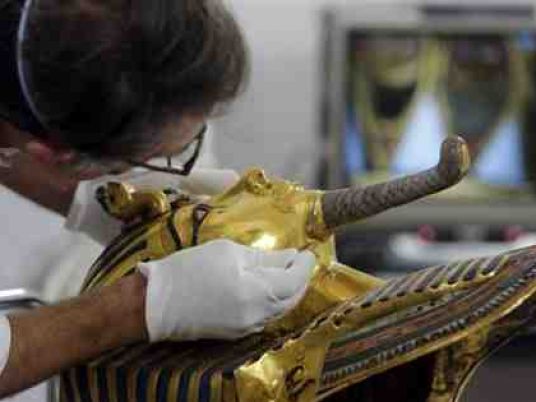
Restorers put their work on the famed golden burial mask of King Tutankhamun on display in Cairo on Tuesday, over a year after the beard was accidentally knocked off and hastily glued back on with epoxy.
A German-Egyptian team of experts showed off the mask in a laboratory in the Egyptian Museum, detailing plans for how the epoxy will be scraped off and the beard carefully removed before being reattached by a method to be determined by a joint scientific committee.
Christian Eckmann, the lead restoration specialist, said the work should take a month or two, depending on how long it takes to remove the beard, which will be attached after research into how the mask and beard attachment were originally made and joined.
"We have some uncertainties now, we don't know how deep the glue went inside the beard, and so we don't know how long it will take to remove the beard," he said on the sidelines of a news conference with Antiquities Minister Mamdouh el-Damaty and Tarek Tawfik, director-general of the still-under-construction Grand Egyptian Museum near the pyramids.
"We try to make all the work by mechanical means … we use wooden sticks which work quite well at the moment, then there is another strategy we could implement, slightly warming up the glue," he said. "It's unfortunately epoxy resin which is not soluble."
A museum employee knocked the beard off during work on the relic's lighting in August 2014, after which it was hastily reattached with epoxy. When the error was revealed in January, the Antiquities Ministry quickly called a press conference where Eckmann said he and an Egyptian team could fix the epoxy-job and avoid permanent damage.
The 3,300-year-old pharaonic mask was discovered in Tutankhamun's tomb along with other artifacts by British archeologists in 1922, sparking worldwide interest in archaeology and ancient Egypt.
It is arguably the best-known piece in the museum, one of Cairo's main tourist sites, which was built in 1902 and houses ancient Egyptian artifacts and mummies.
Eckmann said that during the restoration, experts would conduct a detailed study of the mask's ancient manufacture technique that had not been done previously to determine what materials and techniques were used.
"We are using this chance to gain new information about the manufacture," he said.
